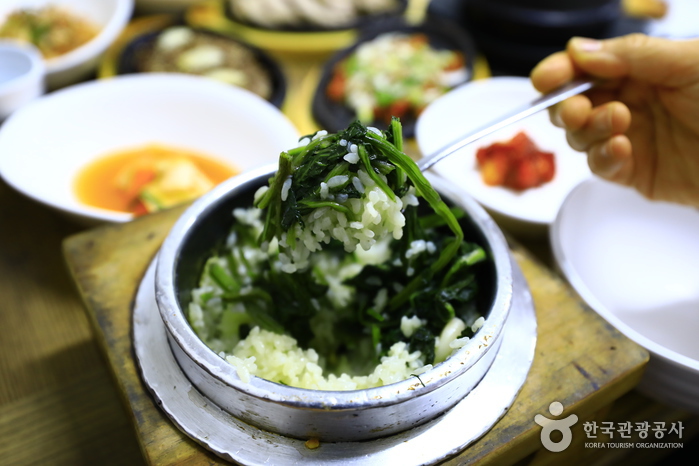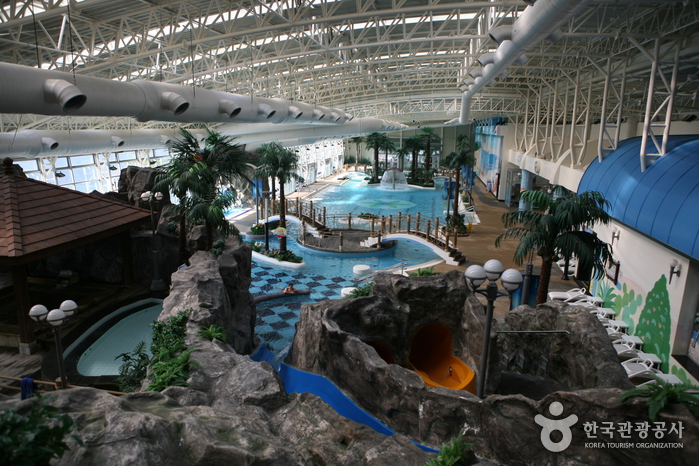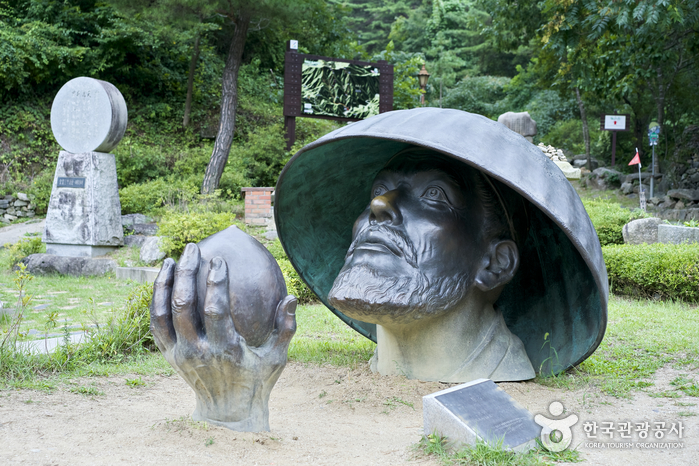Doljip Sikdang (돌집식당)
15.7 Km 24527 2024-02-26
11, Jungang 2-ro, Danyang-eup, Danyang-gun, Chungcheongbuk-do
Doljip Sikdang is a restaurant near the Danyang Bus Terminal that serves dolsotbap (hot stone pot rice) and garlic dishes. Indeed, its gondeure maneul jeongsik (thistle and garlic set menu) has captured the tastebuds of its regulars for two generations. The restaurant’s set menus, such as heungmaneul jeongsik (black garlic set menu), doljip jeongsik (Doljip set menu), gondeure maneul jeongsik (thistle and garlic set menu), and gondeure jeongsik (thistle set menu), all feature garlic dishes. It also serves a la carte dishes like bulgogi, maneul yukhoe (garlic and beef tartare), Danyang maneul tteokgalbi (grilled garlic and galbi patties), suyuk (boiled pork slices), and deodeok gui (grilled deodeok). Notably, side dishes are made with garlic, Danyang’s specialty, which isn’t too spicy and taper off to gentle sweetness.
Sono Moon Danyang Ocean Play (소노문 단양 오션플레이)
16.1 Km 44849 2021-07-09
187-17, Sambong-ro, Danyang-gun, Chungcheongbuk-do
+82-1588-4888
Sono Moon Danyang Ocean Play is an indoor water park supplying clean heated water. With numerous hot springs and amusement facilities that are open year round, it is the perfect vacation spot for families, couples and friends. The water park has the biggest bade pool in Korea as well as pools including couple bath, cave bath, event bath and more. The health pool with carbonated water will help guests relax from the hustle and bustle of the city life.
Sono Moon Danyang (소노문 단양(구 대명리조트 단양))
16.1 Km 21268 2021-07-02
187-17, Sambong-ro, Danyang-gun, Chungcheongbuk-do
+82-1588-4888
Sono Moon Danyang is located in the central region of Korea where various famous landmarks like Eight Scenic Spots of Danyang, Chungjuho Lake, Sobaeksan Moutain, Gosudonggul Cave, and Guinsa Temple are situated. The resort is thought to be a base camp for resting, leisure and sports. The resort also features a 8-meter-high grand aquarium, housing 22,000 freshwater fish from 187 different species in Danuri Aquarium, is the largest freshwater fish ecological hall in Korea. Aqua World is a special facility of Danyang Resort available all year round for health and resting. Natural carbonated water from 750 meters underground is used for varied baths. The bade pool is largest of its kind in Korea and gives a fun experience of a health pool with carbonated water.
Kim Satgat Historic Site (난고 김삿갓 유적지)
16.3 Km 30943 2024-02-16
216-22 Gimsatgat-ro, Gimsatgat-myeon, Yeongwol-gun, Gangwon-do
Nango Kim Satgat (1807-1863) was a prominent literary figure who traveled extensively across the Korean Peninsula, leaving behind a rich legacy of literary works. His sobriquet “Satgat” originated from his habitual wearing of a “satgat” (a traditional Korean hat) and his preference for introducing himself by this name. The historic site dedicated to him includes several key features: the house where he once lived, his tomb, a literary museum that showcases his life and works, and a sculpture of the poet.
Sogang House [Korea Quality] / 소강고택 [한국관광 품질인증]
16.4 Km 5128 2022-03-31
22, Baraemi-gil, Bonghwa-eup, Bonghwa-gun, Gyeongsangbuk-do
+82-10-9189-5578
Located in Baraemi Village, Bonghwa, Gyeongsangbuk-do, Sogang House is a hanok that is over 100 years old. Baraemi Village, the Uiseong Kim clan village, has lots of old houses remaining, but Sogang House has an outstanding history and ambiance. The house was built around 1910 by Namho Kim Roi-sik, a renowned wealthy patriot in Gyeongsang-do, for his second son, Sogang Kim Chang-gi when he was married. Kim Roi-sik is a figure who donated the money secured on his whole possession when the Provisional Government of Korea in Shanghai was raising contributions, and received the Order of Merit for National Foundation. Sogang House is a D-shaped hanok with the adjoining sarangchae and anchae. Even the door frame of the house is built with the chunyang pine, showing the elaboration put in its building. As it is not easily twisted or rotten, chunyang pine is the best pine for architecture that was used for building the palace, the temple, and houses of aristocrats in the Joseon period. There are six guest rooms, including Sarangbang and Eosabang. Sarangbang contains two rooms and veranda, Seonbibang is the room that sunshine comes in the earliest in the morning, and Doryeongbang is the only ondol (floor-heated) room that is built with red clay. Every room has an air-conditioner and the lovely garden with a flower tree is seen through the open window.
The Namho house [Korea Quality] / 남호구택 [한국관광 품질인증]
16.4 Km 117 2020-09-03
21, Baraemi-gil, Bonghwa-gun, Gyeongsangbuk-do
+82-54-673-2257
Located in Bonghwa-eup, Bonghwa-gun, Gyeongsangbuk-do, Bonghwa Namho Gutaek is an old house from the Chosun period designated as Cultural Property Material No. 385. It was built by Nongsan Kim Nam Yeong in 1876 and his son Namho Kim Roe Sik had lived there. Mr. Kim Roe Sik was awarded with a medal for contributing his entire asset to military fund for the Provisional Government of Korea. The spirit of putting others and his country before himself continues until now. Having been built with high-quality materials, the 140-year old Namho Gutaek has barely suffered any deformation. In addition, attentive care added by the descendants has kept the traditional beauty of the hanok intact. One may even feel reverence at the Sosel Daemun (gate). In harmony with the hanok, the garden in the yard and the flower bed sitting next to the wall change color as season changes. It is a great place to feel the scent of old trees and get some rest. In 2016, the shared toilet was renovated in modern style to alleviate any inconvenience for the guests. In the spacious yard, there’s a spot for traditional games such as Tuho, Jegichagi, Neoltuigi, etc. Bonghwa Station (Yeongdong Line) is about a 15- minute walk away; an inner city bus stop in the town, on the other hand, makes a trip to other regions easy.
Olive Young - Gyeongbuk Yeongju Station Branch [Tax Refund Shop] (올리브영 경북영주역점)
16.4 Km 0 2024-06-27
35, Daehak-ro, Yeongju-si, Gyeongsangbuk-do
-
Tohyang traditional house [Korea Quality] / 토향고택 [한국관광 품질인증]
16.5 Km 10790 2020-09-10
43, Baraemi 1-gil Bonghwa-eup, Bonghwa-gun, Gyeongsangbuk-do
+82-10-8575-9036
This historic house has been the home of the descendants of Kim Yeo-byeong, one of the tenth-generation ancestors of its current occupants. Kim Yeo-byeong was born as the fourth son of Kim Seong-gu (courtesy name: Oheon, 1641-1707), founder of Uiseong Kim's Clan at Baraemi Village in Bonghwa and who was a great-great-great grandson of eminent Neo-Confucian official-scholar Kim U-goeng (courtesy name: Gaeam, 1524-1590). The house is comparatively large, featuring a square layout with a lofty five-bay gate building (soseuldaemun) and the main house of seven bays. The main building (anchae) of the house, located against the backdrop of a pine hill, is believed to have been built over 400 years ago before the founder of the family arrived at the village. The family guesthouse (sarangchae) was renovated in 1876 by Kim In-sik (courtesy name: Amun, 1855-1910), who served as the caretaker (Chambong) of Sunghyejeon Shrine, and Grand Master Tonghun before founding Joyang School, which would later become the present-day Bonghwa Elementary School. The name of the house, Tohyang, came from the courtesy name of Kim Jung-uk (1924-1967), a grandson of Kim In-sik. The latter was conscripted by the colonial authority ruling Korea at the time to serve the Japanese puppet state Manchukuo but fled during a military drill to become a freedom activist fighting against Imperial Japan in the Chinese cities of Suzhou and Hangzhou. He returned home after the 1945 Korean Liberation and studied in Jungang High School and Korea University before serving as a budget officer at the Economic Planning Board. The name of the house inscribed on the plaque hung under the roof of the gatehouse was written by his son Kim Jong-gu in honor of his life and achievements. At the front courtyard of the house is a lotus pond including barbecuing equipment and pottery kiln. In the rear garden is a folk playground with facilities and equipment for swinging, traditional Korean seesaw, shuttlecock-kicking, pitch-pot, and top spinning. The front courtyard also features rustic ceramic pots and rooftiles bearing poetic passages written by the mistress of the house who is a prize-winning poetess. The house provides visitors with an opportunity to experience traditional Korean cultural heritage such as pottery, calligraphy, poetry, and traditional musical instruments. Rich with the heritage of traditional Korean culture and lifestyle, the Historic House of Tohyang guides visitors to refreshment and healing obtained from the legacy of the peaceful rural life of days gone by.
Homeplus - Yeongju Branch [Tax Refund Shop] (홈플러스 영주)
16.5 Km 0 2024-04-18
29, Daehak-ro, Yeongju-si, Gyeongsangbuk-do
-
Manhoegotaek [Korea Quality] / 만회고택 [한국관광 품질인증]
16.5 Km 3569 2023-11-30
51 , Baraemi 1-gil, Bonghwa-gun, Gyeongsangbuk-do
+82-54-673-7939, +82-10-8079-7939
The prestigious Manhoe Old House in Baraemi Village, Bonghwa, Gyeongsangbuk-do, is a nationally designated folk cultural asset, because of its 300 year history and its association with both Korean literature and the March 1st independence movement. It is said that a thousand poems were written in Myeongwolru, the Old House’s pavilion; and the 1919 Independence Petition was also written here. There are 7 guestrooms, one with an attic with exposed roofbeams, and most but not all rooms have individual toilets. Guests can take part in traditional activites such as folk games.




![Sogang House [Korea Quality] / 소강고택 [한국관광 품질인증]](http://tong.visitkorea.or.kr/cms/resource/80/2803880_image2_1.jpeg)
![The Namho house [Korea Quality] / 남호구택 [한국관광 품질인증]](http://tong.visitkorea.or.kr/cms/resource/90/2626090_image2_1.jpg)

![Tohyang traditional house [Korea Quality] / 토향고택 [한국관광 품질인증]](http://tong.visitkorea.or.kr/cms/resource/57/2627457_image2_1.jpg)
![Manhoegotaek [Korea Quality] / 만회고택 [한국관광 품질인증]](http://tong.visitkorea.or.kr/cms/resource/38/3042238_image2_1.jpg)
 English
English
 한국어
한국어 日本語
日本語 中文(简体)
中文(简体) Deutsch
Deutsch Français
Français Español
Español Русский
Русский